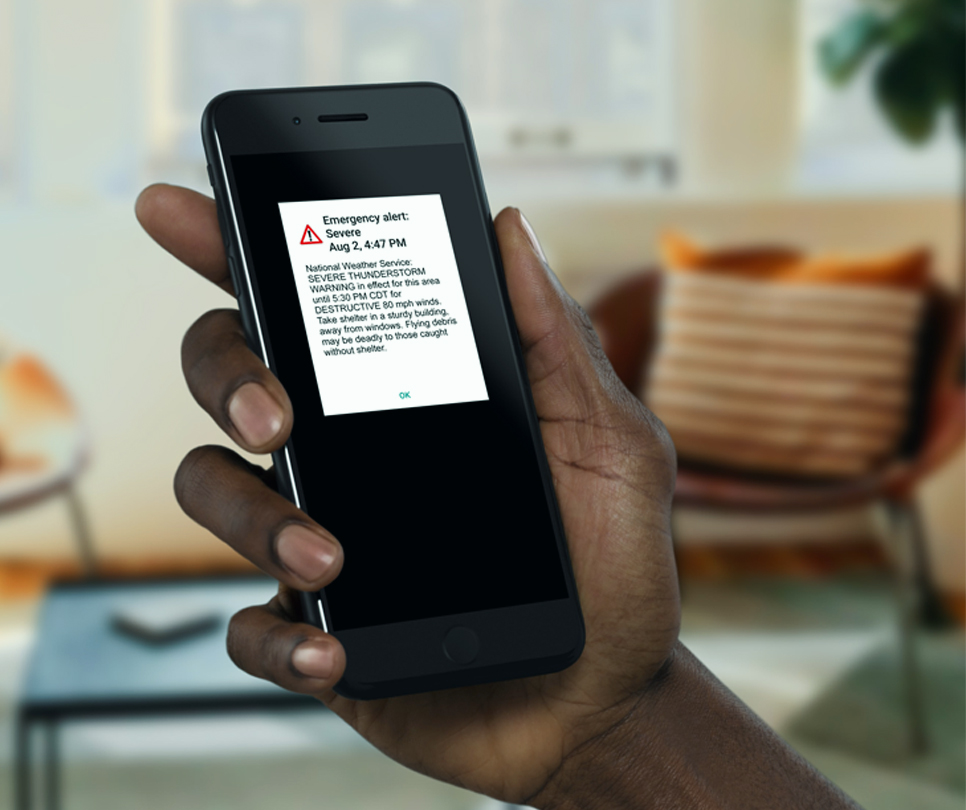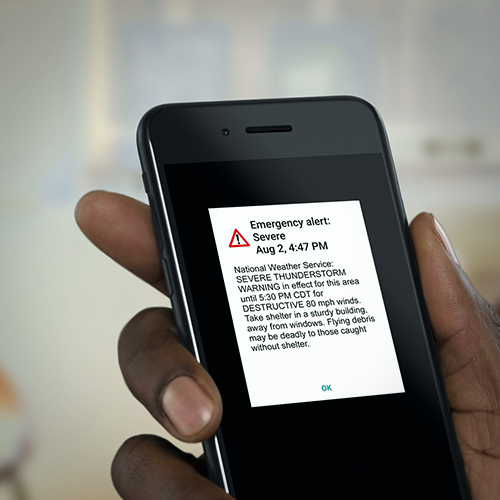
Be Prepared
Emergency Alerts & Warnings
When emergencies strike, public safety officials use timely and reliable systems to alert you. This page describes different warning alerts you can get and how to receive them.

Wireless Emergency Alerts (WEAs) are short emergency messages from authorized federal, state, local, tribal and territorial public alerting authorities that can be broadcast from cell towers to any WEA‐enabled mobile device in a locally targeted area. WEAs can be sent by state and local public safety officials, the National Weather Service, the National Center for Missing and Exploited Children and the President of the United States.
- WEAs look like text messages but are designed to get your attention with a unique sound and vibration repeated twice.
- WEAs are no more than 360 characters and include the type and time of the alert, any action you should take and the agency issuing the alert.
- WEAs are not affected by network congestion and will not disrupt texts, calls or data sessions that are in progress.
- You are not charged for receiving WEAs and there is no need to subscribe.
Types of Wireless Emergency Alerts
Presidential Alerts are a special class of alerts only sent during a national emergency.
Imminent Threat Alerts include natural or human-made disasters, extreme weather, active shooters, and other threatening emergencies that are current or emerging.
Public Safety Alerts contain information about a threat that may not be imminent or after an imminent threat has occurred. Public safety alerts are less severe than imminent threat alerts.
America’s Missing: Broadcast Emergency Response (AMBER) Alerts are urgent bulletins issued in child-abduction cases. Rapid and effective public alerts often play a crucial role in returning a missing child safely. An AMBER Alert instantly enables the entire community to assist in the search for and safe recovery of the child. Law enforcement assembles descriptions and pictures of the missing child, the suspected abductor and any other helpful information.
Test Messages assess the capability of state, local, tribal and territorial officials to send their WEAs. The message will state that this is a TEST.
 If you are not receiving an alert, here are some tips to troubleshoot your mobile device:
If you are not receiving an alert, here are some tips to troubleshoot your mobile device:
If someone near you received a WEA and you did not, it may be due to inadequate cell reception, or because when on a call, some mobile phones will not show an alert — this varies by make and model.
- Check the settings on your mobile device and review your user manual.
- Older phones may not be WEA capable, and some cell phone models require you to enable WEAs.
- Check with your wireless provider to see if they can resolve the issue.
- All major phone providers and some smaller providers participate in WEA.
Not receiving an alert may also be because your mobile phone is:
- Set to “off” or “airplane mode”
- Not connected to a cell site broadcasting the alert
- Connected to a cell site that is not broadcasting the alert, undergoing maintenance or is out-of-service
- The device is opted out of receiving alerts. The location of the alerts opt-in/opt-out menu typically is in the notification settings menu.
- If your mobile phone continues to receive the same WEA over and over it is most likely an issue with the device. Mobile phones should ignore subsequent re-broadcasts of a WEA but sometimes a device gets stuck in a loop repeatedly alerting for the same WEA. Powering off the device and turning it back on may help.
The Emergency Alert System (EAS) is a national public warning system that allows the president to address the nation within 10 minutes during a national emergency. State and local authorities may also use the system to deliver important emergency information such as weather information, imminent threats, AMBER alerts and local incident information targeted to specific areas.
- The EAS is sent through broadcasters, satellite digital audio services, direct broadcast satellite providers, cable television systems and wireless cable systems.
- The President has sole responsibility for determining when the national-level EAS will be activated. FEMA and the FCC are responsible for national-level tests and exercises.
- The EAS is also used when all other means of alerting the public are unavailable.
NOAA Weather Radio All Hazards (NWR) is a nationwide network of radio stations that broadcast continuous weather information from the nearest National Weather Service office based on your physical location.
- NWR broadcasts official warnings, watches, forecasts and other hazard information 24 hours a day, seven days a week.
- NWR also broadcasts alerts of non-weather emergencies such as national security or public safety threats through the Emergency Alert System.
